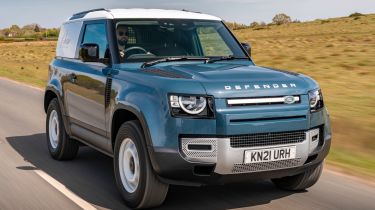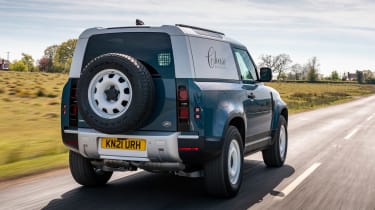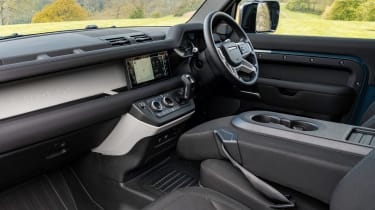Land Rover Defender Hard Top van review
The cargo-carrying Defender Hard Top offers a premium image for businesses in need of a vehicle that stands out from the crowd

Our opinion on the Land Rover Defender Hard Top
The Land Rover Defender Hard Top is an excellent vehicle in its own right, being fantastic to drive and luxurious in ways most commercial vehicles could never match. But its price is way beyond what a normal business would be willing to pay, especially since a van or pickup would be significantly more practical and economical to buy and run. It’s a niche product, but a fantastic option for the people it does work for.
About the Land Rover Defender Hard Top
The Land Rover Defender Hard Top is a commercial version of the popular SUV designed for businesses needing a vehicle that can head off road and also serve as an upmarket billboard for their services.
The Defender Hard Top comes in 90 and 110 (short and long wheelbase) guises - just like the Defender SUV - but there’s no extra long 130 variant and rest of the range isn't quite as broad. On both wheelbase versions, you can only get the D250 diesel engine in entry-level S and mid-spec X-Dynamic SE trims but a more powerful D350 engine is available on the top-spec X-Dynamic HSE version. Prices start at just over £57,000 and rise to over £75,000 for the top-spec model.
That's less than the asking price of the Defender SUV, but where that car is designed for transporting people, the Defender Hard Top replaces its back seats with a large cargo area. The seats, belts and other passenger car paraphernalia are stripped out, and a hard plastic floor is added in their place. This stretches from the side-hinged tailgate to the back of the front seats, where Land Rover has fitted a hard plastic partition.
On the outside, the rearmost windows on both models are replaced by plastic trim. While the rear side doors on the Defender 110 are still in place, they gain heavily tinted glass and the electric windows no longer function. Inside there is hard plastic protection for the windows for added security.
Used - available now

2022 Abarth
595
26,293 milesManualPetrol1.4L
Cash £15,700
2021 Jaguar
XE
45,309 milesAutomaticPetrol2.0L
Cash £21,300
2022 Nissan
Qashqai
11,077 milesAutomaticPetrol1.3L
Cash £18,499
2023 Tesla
Model Y
64,942 milesAutomaticElectric
Cash £21,500Aside from these changes, the Defender Hard Top looks identical to the SUV. That means a similarly broad range of options can be offered, with a wide choice of wheels, exterior, interior and seating upgrades available.
One area where the Defender Hard Top stands out is in the cabin. This is carried over wholesale from the SUV, so it features the same well-equipped and high-quality interior – aside from the bulkhead directly behind the front seats, you could easily assume you're sitting in the SUV. The Defender is a two-seater, although the SUV's jump seat is available as an option to create a three-seat cabin, albeit a rather tight one.
Overall, the Land Rover Defender Hard Top is a pretty unique proposition. Its only direct rival is Land Rover's own Discovery Commercial, which offers more space and slightly different kit, but the same off-road ability. Elsewhere, the Toyota Land Cruiser Commercial comes in the same long and short wheelbases and can match the Defender in the rough, but it's a much more basic proposition inside, with less kit.
Other rivals will be mainly within the one-tonne double cab pick-up truck class. These models offer heavier payloads, but while ride comfort has improved, they can't match the Defender for luxury. Still, models such as the Ford Ranger, Toyota Hilux and Isuzu D-Max are worth considering thanks to their long kit lists and competitive pricing.
MPG and running costs
While Land Rover has its roots in the utilitarian, the brand's current image is that of a premium SUV manufacturer. The Defender Hard Top fits the latter brief, so while it's a commercial vehicle, it comes with a premium price tag that puts it above even premium pick-up trucks and other rival commercial 4x4s.
But you get what you pay for, and the Defender Hard Top is an upmarket commercial vehicle that will suit businesses wishing to convey a premium image. Even the entry-level Defender 90 has that upmarket appearance, so you don't have to splash out on a 110 unless you need the extra space.
The high costs don't stop once you've bought a Defender Hard Top. The whole range is powered by Land Rover's Ingenium six-cylinder diesel, and although they have fuel-saving mild-hybrid tech included, they're thirsty.
Whether you choose the D250 or D350 engine, official combined WLTP fuel economy is pretty much the same, at 33.6 and 33.1mpg respectively. The current WLTP tests mean that these figures are achievable, but expect them to drop if you make the most of the Defender Hard Top's payload.
Load space & practicality
There are two body styles to choose from with the Defender Hard Top, the 90 or the 110. These numbers hark back to the classic Defender, where they used to indicate the wheelbase of each model. However, the new Defender 90 has a wheelbase that's closer in size to the old 110's (at 101.9 inches, or 2,587mm), which just shows how cars have grown in size over the decades.
As well as a shorter wheelbase, the Defender 90 also has a three-door layout. There's a hard plastic bulkhead behind the seats, so this means there's only one way in and out of the cargo area - via the side-hinged back door. While the door has the spare wheel hanging off it, it's actually easy to open on its gas strut, although you need to plan on where you park to ensure you have enough space behind the van to swing it open.
The cargo area in the Defender 90 Hard Top measures 1,326mm wide (1,124mm between the wheelarches), 1,037mm long and 947mm high, and there's a cargo volume of 1.12 cubic metres on offer. The area has a grey rubber floor with plastic sides, and is a square, uniform shape - the sides use the same plastic trim as the SUV – while a flat load lip means loading should be simple. There's a 58-litre lockable under-floor storage area and the Defender's skylight windows in the edges of the roof let some light into the cargo space, too.
In comparison, the Defender 110 is slightly more interesting thanks to its extra doors. These feature opaque black tinted glass on the outside, while inside the SUV's door trim is extended up so the extra plastic covers the other side of the glass - a handy security feature. Opening the side doors also gives access to extra hidden storage where the footwells of the SUV normally are. These 155-litre spaces are accessed from above via the hinged floor, or there's side access if you've filled the main cargo area.
As with the Defender 90, the side-hinged rear door opens easily, but here it opens to reveal a cargo area of 1.7 cubic metres. The floor is longer, at 1,472mm, and there's more space between both the side doors (1,423mm) and the wheelarches (1,160mm). However, the cargo height is slightly lower, at 937mm.
Cargo length and width is a little behind that of a pick-up truck such as the Ford Ranger, and payloads are lower for the Defender Hard Top, too. While double cab pick-ups need to be able to carry more than a tonne of payload to qualify as a commercial vehicle, commercial 4x4s just need to be designed to carry cargo to qualify. As a result, the Defender 90 has a maximum payload weight of 670kg, while the Defender 110 maxes out at 800kg, irrespective of which engine you choose.
One area where the Defender is a match for a pick-up truck is towing. All versions can haul a 3.5-tonne trailer, which matches the best pick-ups around. Of course, if you are towing, then it'll be tricky to open the rear door while your trailer is hitched up, so the Defender 110, with its side doors, is a better option if you still need to access the cargo space.
Reliability, safety and security
Pros |
Cons |
|
|
All Defender Hard Tops come with the same three-year/unlimited mileage warranty as the rest of Land Rover's range, and there's roadside assistance cover for the same period. An extended warranty is available at extra cost that can cover the Defender Hard Top for up to 10 years.
In addition, there's a six-year anti-corrosion warranty and another one for paint that covers the same period, while any parts or accessories that are bought at the same time as the car are also covered for three years.
In terms of reliability, Land Rover doesn't have the best reputation, but with the Defender using the same electronics and running gear as other cars in the range, any software updates will be simple to add and should help the car's reliability.
Safety will be first rate, whichever way you look at it. The standard Defender SUV has a five-star Euro NCAP rating, and with the same safety kit, airbags and electronic systems on board, the Hard Top is an equally safe place to be.
Driving and performance
Pros |
Cons |
|
|
On the road, the Land Rover Defender Hard Top is as accomplished as the SUV. It has a comfortable ride that beats any pick-up truck - whether you're carrying a heavy load or not. The Defender is probably the choice for anybody wanting the most comfortable commercial vehicle there is. Cabin refinement is excellent, there were some creaks from the bulkhead on the cars we drove, but it's not a deal breaker in the slightest.
Bigger wheels do unsettle the ride a little, but you could still hardly call the Defender uncomfortable, and if you've driven a classic Land Rover Defender, the modern version is light years ahead. Where the old car has a cramped driving position that pins you to the driver's door, the new Defender is spacious, although if you add the optional jump seat and fold it down, you'll find the driver's seat is a little cramped in the opposite direction.
The 3.0-litre Ingenium diesel packs a punch, even in D250 guise, and there's plenty of torque on tap. The standard eight-speed auto gearbox slips through the gears with ease, and really takes the strain out of driving.
The Defender Hard Top's showpiece is its off-road ability. The Terrain Response system is the same as you'll find in Land Rover's SUVs, and it offers electronic control of the Defender's power distribution, suspension ride height and diffs to deliver outstanding off-road performance. While other commercial vehicles can be had with four-wheel drive, nothing offers the mix of ability and comfort that a Land Rover does.
Air suspension is available as an option (£1,615) and it brings even more comfort over rough roads and even improves the Defender’s off-road ability as well. Off-road packs are available too that add even more features for those heading out into the wilderness.
Town driving, visibility and parking
Light steering means the Defender is easy to manoeuvre, while front and rear parking sensors and big wing mirrors help you position this large vehicle. One useful option is Land Rover's Clearsight Rear View Mirror. When active, it swaps the standard mirror view for an image relayed from a roof-mounted camera. This is a great addition in the Hard Top, since the mirror view is obscured not only by the spare wheel on the rear door, but also the plastic mesh opening in the bulkhead.
Motorway driving and long-distance comfort
Like the Defender passenger car, the commercial version is excellent at speed with far less wind and road noise than any pick-up you’d care to mention. The engines are strong (you don’t really need to move from the D250 to the D350, although the latter is certainly a strong performer) and give you confidence with overtaking. The Defender is a joy to drive over long distances, at least compared to other commercial options.
Cab interior and technology
Pros |
Cons |
|
|
The Defender Hard Top is just as plush as its SUV counterpart. There are lots of high-quality plastics, metal trim and leather on higher spec models, while the standard kit list is extensive. The main downside of the Defender when compared with the SUV version - or a double cab pick-up, for that matter - is the lack of passenger space. It's not cramped, but the Hard Top's status as a commercial vehicle means it's only a two-seater.
You can add a third 'Jump Seat' between the front seats, but cabin space is a little cramped in this layout, and there will be a lack of shoulder room if you travel three-up. A better option is to fold this seat down, where it doubles as a table with cup holders and a bank of charging sockets at the base of the seat.
You get a good view of the road ahead from behind the wheel, while extra sensors allow you to position this large 4x4 relatively easily. Light controls help here as well.
Infotainment, sat-nav and stereo
All models come with a 12.3-inch Interactive Driver Display and ‘Pivi Pro’ (Land Rover’s infotainment display on the dash), a Meridian stereo system, DAB radio, Android Auto and Apple CarPlay. The touchscreen system is full-featured and decently responsive, although the interface isn’t as intuitive as some would like. You’ll, of course, get used to using it over time, but finding lesser-used functions is sometimes not as easy as it could be.
Buying and owning
It’s not all that easy to justify a Defender Hard Top, simply because the with purchase price is nearly £60,000 - even for the base model - is almost double what you might pay for a pick-up with similar off-road ability, almost as much kit and more carrying capacity. Only the Land Rover can offer this level of luxury in a commercial vehicle, though, and for certain businesses that value image highly it certainly could make sense.
Alternatives
Most of the normal pick-up options such as the Toyota Hilux or Isuzu D-Max are much cheaper than the Defender, but are chosen because of their rugged dependability on and off-road. They are also more practical than the Land Rover in many ways, but they can’t match its luxurious image and interior. The Land Rover Discovery Commercial is pretty much the only other option in that sense.
Van dimensions
| |||
| Body style | Height | Width | Length |
| Defender 90 | 1,974mm | 2,008mm | 4,323mm |
| Defender 110 | 1,972mm | 2,008mm | 4,758mm |
Load area dimensions | ||||
| Body style | Height | Width | Length | Volume |
| Defender 90 | 947mm | 1,326mm | 1,037mm | 1.12m3 |
| Defender 110 | 937mm | 1,423mm | 1,472mm | 1.7m3 |
Frequently Asked Questions
As a van it’s not great, and it’s incredibly expensive. It’s more of a car that’s technically classed as a van, although it does have better carrying capacity than the SUV version, as you’d expect.








